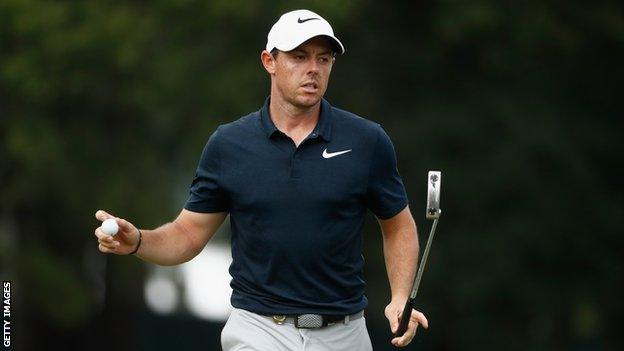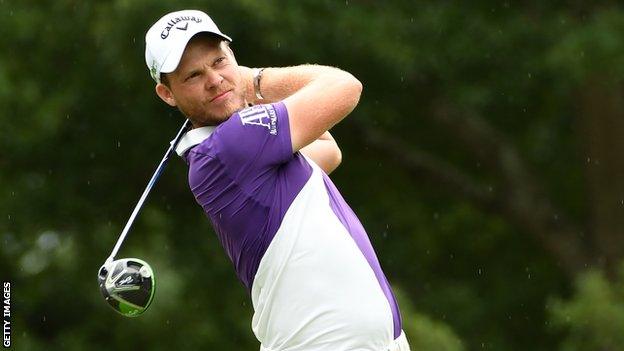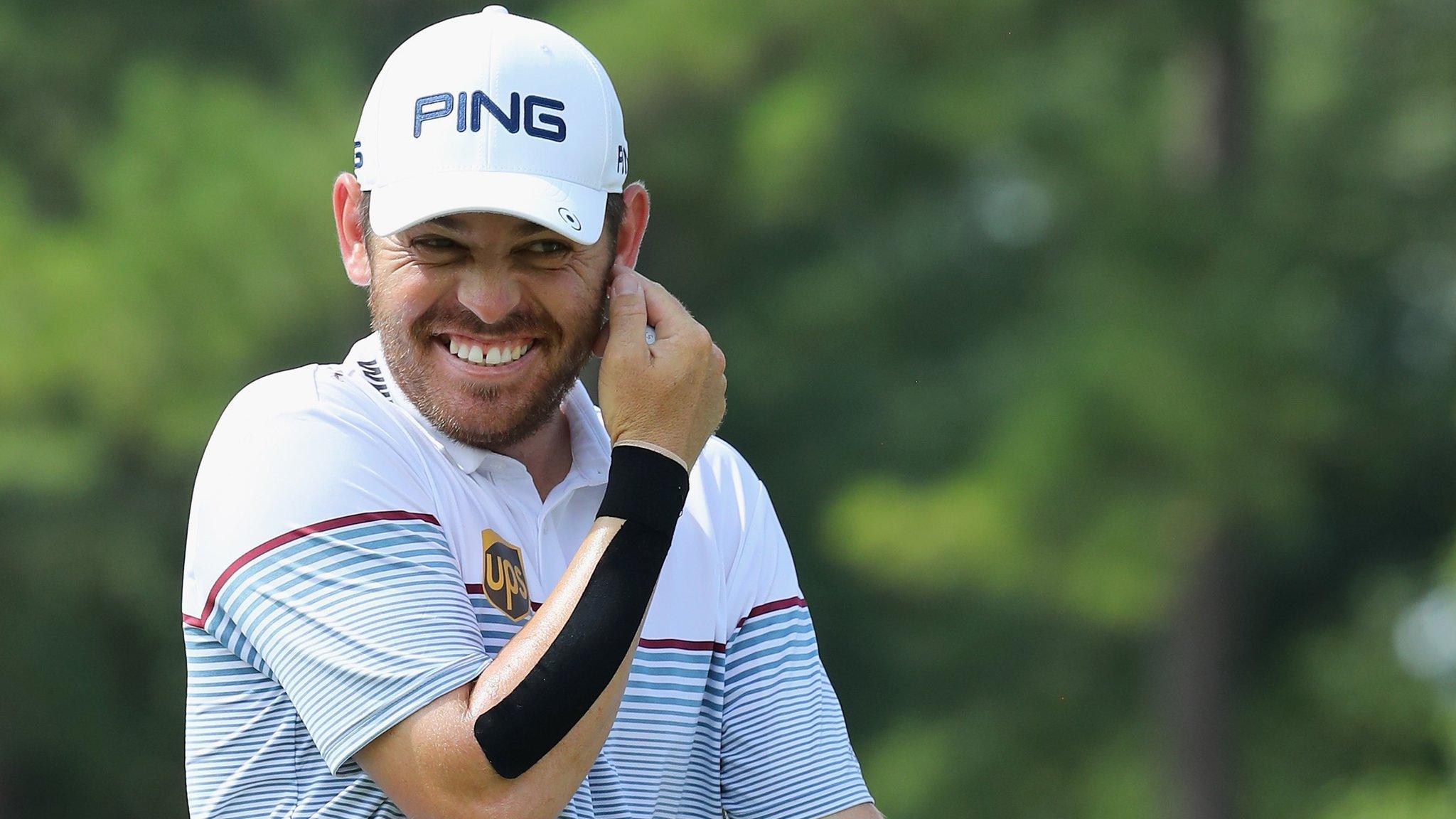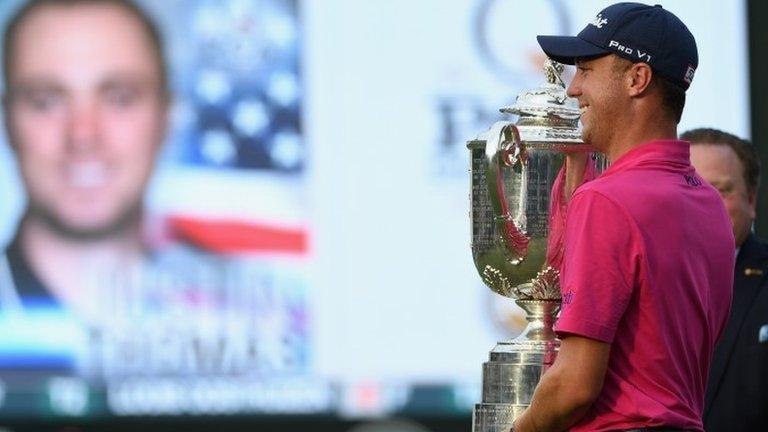Masters, US Open, The Open, US PGA Championship: What 2017 majors taught us
- Published
- comments

Sergio Garcia (left) was the only non-American major winner this year
Justin Thomas' thrilling victory at the US PGA Championship brought down the curtain on a remarkable year in golf's majors.
Sergio Garcia set the tone with his astonishing Masters triumph in April, before Brooks Koepka made his breakthrough at the US Open and Jordan Spieth won The Open.
With Thomas' victory, the past three majors have been won by Americans with an average age of 25. So what have we learned from the four biggest tournaments that define the men's game in 2017?
The strength of American golf
The US regained the Ryder Cup last autumn and Europe must be relieved the next match is not this September. There is frightening strength in depth in the American game as Koepka, Spieth and now Thomas have proved.
They all trail Dustin Johnson in the world rankings, the world number one's major season having been ruined by the injury he sustained in a freak fall on the eve of the Masters.
Matt Kuchar was runner-up to Spieth at The Open, Rickie Fowler's fifth place at Quail Hollow was his second top five of the year in a major and Patrick Reed was joint runner-up in the US PGA.
Furthermore, there is a unique chemistry and camaraderie among this generation of American players. Thomas and Fowler were waiting to congratulate Spieth at Royal Birkdale and The Open champion was among those who returned the compliment in Charlotte last Sunday.
"We obviously all want to win," Thomas said. "We want to beat the other person - but if we can't win, we at least want to enjoy it with our friends.
"I think that we'll all be able to enjoy this together and I know it's going to make them more hungry, just like it did me, for Jordan [at The Open]."
Rory McIlroy needs full fitness

Rory McIlroy was the pre-tournament favourite at Quail Hollow, but was out of contention after three rounds
As BBC Radio 5 live's Jay Townsend told listeners: "He basically threw away the whole year. If you are not fit, you can't compete."
The strength in depth at the top of the game means that even with Rory McIlroy's incredible talent, he cannot keep up with the biggest names unless he is able to practise without physical hindrance.
The 28-year-old Northern Irishman shared fourth at The Open, external - his best major performance of the year - but he was never genuinely in contention at Birkdale and, after finishing 22nd at Quail Hollow,, external he revealed he suffers back spasms following most rounds he plays.
It means his time on the range has to be curtailed and he has still not fully recovered from the rib problem that has blighted his year.
Now is the time to take a break. There is no Ryder Cup and he has the opportunity to fully recover before embarking on a vital season next year.
The four-time major champion has not won one for three years, but given the freak ankle injury of 2015 and his current problems he has rarely been properly fit in that period.
UK golf is in a state of transition
Justin Rose was second to Garcia at the Masters and Tommy Fleetwood came fourth at the US Open, but otherwise there was little to excite UK golf fans.
Rose never recovered from the disappointment of his play-off loss to the popular Spaniard, while Fleetwood looks the best prospect to kick on after his experience at Erin Hills.

Following his Masters victory in 2016, Danny Willett rose to world number nine - but is now 50th in the rankings
Danny Willett, the 2016 Masters champion, has suffered a horrible year with a collapse of form and fitness. Like McIlroy he needs to take himself out of the firing line, heal his back and find a way to fulfil huge potential.
The generation of Tyrrell Hatton, Chris Wood, Andy Sullivan and Matthew Fitzpatrick remain a class below their American counterparts on major championship layouts. They have to find a way of competing on the biggest stages.
Jordan Smith made a hugely impressive major debut with his 9th-place finish at Quail Hollow, fresh from his European Open triumph at the end of last month.
Major golf courses are too long

Erin Hills, which hosted the 2017 US Open, is a 7,845-yard course, the longest in major championship history
Erin Hills, which staged the US Open, was a step too far - indeed hundreds of steps too far. When courses are stretched to 7,800 yards to cope with the vast distance the modern golf ball travels, we know that something needs to be done.
Privately, there are leading officials who acknowledge change is required. One very highly placed American official told me: "Golf is the only sport where we expand the field of play to accommodate changes in the game."
Such length adversely affects the time it takes to play rounds and makes golf an out-and-out power game that compromises the need for guile and skill. The sport has become too one-dimensional and set-ups can often be too penal to keep scores in check.
Nothing wrong with major record being broken
Grace shoots record-breaking 62 with putting masterclass
This was the year when the golfing gods finally relented at a men's major and allowed a 62 to be carded. Branden Grace's brilliant score was compiled on a rain-softened Royal Birkdale course set up for low scoring.
It led to a thrilling day, with vast crowds delighting in birdies and eagles aplenty. That Saturday in Southport was a day when the world's best could show us their full range of skills.
But those who were not on their game still struggled. McIlroy blew a brilliant start to that third day and this may well have been the round that made up his mind to part ways with caddie JP Fitzgerald.
Majors still matter, especially The Open
For me, the abiding memory of this year's majors were provided by the Birkdale crowds. The queues of fans entering the course were reminiscent of Wembley Way on FA Cup final day.
Opens staged in the north west of England are the best attended outside St Andrews and are populated by passionate and knowledgeable galleries that generate one of the greatest atmospheres in all of sport.
That was the case at Royal Birkdale in July, even though Spieth's third major success was a further illustration of the American domination that reflects golf's current balance of power.
- Published14 August 2017

- Published14 August 2017

- Published14 August 2017

- Published8 August 2017
